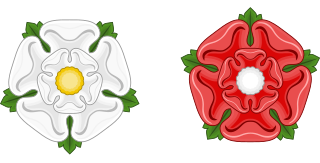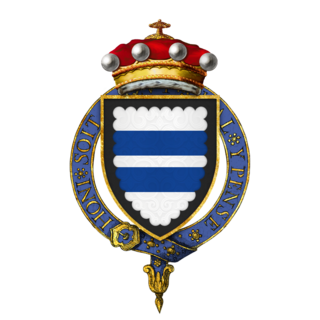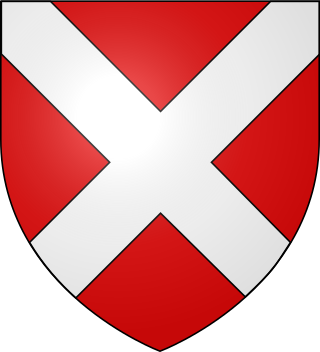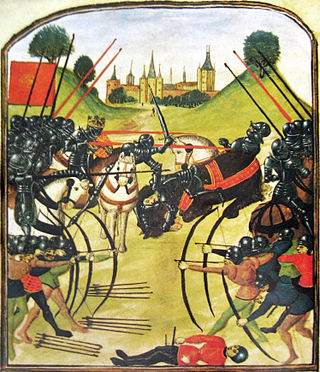Related Research Articles

Edward IV was King of England from 4 March 1461 to 3 October 1470, then again from 11 April 1471 until his death in 1483. He was a central figure in the Wars of the Roses, a series of civil wars in England fought between the Yorkist and Lancastrian factions between 1455 and 1487.

Richard Neville, 16th Earl of Warwick, 6th Earl of Salisbury, known as Warwick the Kingmaker, was an English nobleman, administrator, landowner of the House of Neville fortune and military commander. The eldest son of Richard Neville, 5th Earl of Salisbury, he became Earl of Warwick through marriage, and was the wealthiest and most powerful English peer of his age, with political connections that went beyond the country's borders. One of the leaders in the Wars of the Roses, originally on the Yorkist side but later switching to the Lancastrian side, he was instrumental in the deposition of two kings, which led to his epithet of "Kingmaker".
John Neville, 1st Marquess of Montagu was a major magnate of fifteenth-century England. He was a younger son of Richard Neville, 5th Earl of Salisbury, and the younger brother of Richard Neville, Earl of Warwick, the "Kingmaker".

The Battle of Edgcote took place on 24 July 1469, during the Wars of the Roses. It was fought between a royal army, commanded by the earls of Pembroke and Devon, and a rebel force led by supporters of the Earl of Warwick.

The Battle of Losecoat Field was fought on 12 March 1470, during the Wars of the Roses. Spellings of "Losecoat" vary, with "Losecote" and "Loose-coat" also seen.
The Lord Warden of the Marches was an office in the governments of Scotland and England. The holders were responsible for the security of the border between the two nations, and often took part in military action. They were also responsible, along with 'Conservators of the truce', for administering the special type of border law known as March law.

Sir William Parr, KG (1434–1483) was an English courtier and soldier. He was the eldest son of Sir Thomas Parr (1405–1461) and his wife Alice, daughter of Sir Thomas Tunstall of Thurland, Lancashire.
Robert Welles, 8th Baron Willoughby de Eresby and 8th Baron Welles, was the son of Richard Welles, 7th Baron Welles, and Joan Willoughby, 7th Baroness Willoughby de Eresby. He was the prime mover in an uprising against Edward IV in 1470, although his actions were possibly orchestrated by Richard Neville, 16th Earl of Warwick.

John Bourchier, 1st Baron Berners, KG was an English peer.
Events from the 1460s in England.

Sir Humphrey Stafford, 1st Earl of Devon, 1st Baron Stafford of Southwick was a dominant magnate in South West England in the mid-15th century, and a participant in the Wars of the Roses. A distant relative of the Earls of Stafford, Humphrey Stafford became the greatest landowner in the county of Dorset through fortunes of inheritance. Later, Stafford was one of several men promoted rapidly through the nobility by King Edward IV, to fill the power vacuum left by dead or forfeit Lancastrians. In the West Country it was particularly the forfeitures of the Lancastrian Courtenay family that benefited Stafford. In 1469 he received the Courtenay title of Earl of Devon.

The Neville or Nevill family is a noble house of early medieval origin, which was a leading force in English politics in the later Middle Ages. The family became one of the two major powers in northern England and played a central role in the Wars of the Roses along with their rival, the House of Percy.
Richard Welles, 7th Baron Welles (c.1428–1470), was an English nobleman and soldier. From a Lancastrian family, he came to be on good terms with the Yorkist King Edward IV, but was later executed after being associated with a plot against Edward known as the "Welles Uprising".

The Readeption was the restoration of Henry VI of England to the throne of England in 1470. Edward, Duke of York, had taken the throne as Edward IV in 1461. Henry had fled with some Lancastrian supporters and spent much of the next few years in hiding in Northern England or in Scotland, where there was still some Lancastrian support. Henry was captured in 1465 and was held as a prisoner in the Tower of London. Following dissent with his former key supporter, Richard Neville, 16th Earl of Warwick, Edward was forced to flee in 1470. Henry was then restored to the throne, although he was deposed again the following year.

The Wars of the Roses (1455–1487), known at the time and for more than a century after as the Civil Wars, was a series of civil wars fought over control of the English throne in the mid-to-late fifteenth century. These wars were fought between supporters of two rival cadet branches of the royal House of Plantagenet: Lancaster and York. The wars extinguished the last male line of the House of Lancaster in 1471, leading to the Tudor family inheriting the Lancastrian claim to the throne. Following the war and the extinction of the last male line of the House of York in 1485, a politically arranged marriage united the Houses of Lancaster and York, creating a new royal dynasty which inherited the Yorkist claim as well, thereby resolving the conflict.

William Willoughby, 5th Baron Willoughby de Eresby KG was an English baron.

Richard Neville, 2nd Baron Latimer KB of Snape, North Yorkshire, was an English soldier and peer. He fought at the battles of Stoke and Flodden.
Sir Richard Hastings, Baron Welles, was the son of Sir Leonard Hastings and a younger brother of William Hastings, 1st Baron Hastings. He was a favourite of Edward IV, who granted him the lands of the baronies of Willoughby and Welles after he had married the heiress, Joan Welles. He fought at Tewkesbury. He died in 1503, and was buried at the Greyfriars, London.
Sir John Conyers, one of twenty-five children of Christopher Conyers, was a pre-eminent member of the gentry of Yorkshire, northern England, during the fifteenth century Wars of the Roses.
The Lincolnshire Rebellion was a popular uprising against King Edward IV in 1470. It was sponsored by Richard Neville, 16th Earl of Warwick, who had once been loyal to the king but had gradually fallen out with him, opposing his unpopular marriage and aspects of English foreign policy.
References
- ↑ Gillingham 1982, p. 161.
- ↑ Evans 2019, pp. 49–55.
- ↑ Penn 2019, pp. 203–205.
- ↑ Gillingham 1982, p. 160.